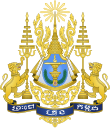Đại Việt–Khmer War
| Đại Việt–Khmer War | |||||||
|---|---|---|---|---|---|---|---|
| Part of Khmer–Cham wars | |||||||
 Map of Southeast Asia between the 1000–1100 | |||||||
| |||||||
| Belligerents | |||||||
| Đại Việt (Lý dynasty) |
| ||||||
| Commanders and leaders | |||||||
| Strength | |||||||
| 30,000 soliders |
20,000 soldiers (1238) •700 ships | ||||||
The Đại Việt–Khmer War were a series of wars and conflicts fought between the Kingdom of Đại Việt and the combined forces of Champa and the Khmer Empire between 1123 and 1150.
Background
[edit]In 1127, King Ly Nhan Tong died. 12-year-old Ly Than Tong ascended the throne. Taking advantage of this opportunity, King Suryavarman II immediately sent troops to invade Dai Viet.
The conflicts
[edit]
The first attack was in 1128 when King Suryavarman II led 20,000 soldiers from Savannakhet to Nghệ An but were routed in battle. The following year Suryavarman continued skirmishes on land and sent 700 ships to attack Nghệ An.Đại Việt sent general Dương Ngộ in Nghe An and Nguyễn Hà Viêm who was stationed in Thanh Hóa to fight back, the Khmer army was defeated a second time. After 4 years of preparation, in 1132, the combined forces of the Khmer Empire and Champa attacked Đại Việt by sea. From Nghệ An, the war spread to Thanh Hóa, Đại Việt sent lieutenant Dương Anh Nhĩ and the royal army to fight back, the Khmer and Champa army were defeated. In 1137, Khmer attacked Đại Việt for the 4th time, requesting Champa to send troops to coordinate but was refused. King Lý Thần Tông sent Lieutenant Lý Công Bình to fight back, and won. In 1150, the Khmer army attacked Đại Việt for the 5th time but was defeated. King Suryavarman II died in battle in Hà Tĩnh, ending the Đại Việt-Khmer war.
Aftermath
[edit]After a failed attempt to seize seaports in southern Đại Việt, Suryavarman turned to invade Champa in 1145 and sacked Vijaya, ending the reign of Jaya Indravarman III and destroying the temples at Mỹ Sơn.[1][2] Inscriptional evidence suggests that Suryavarman II died between 1145 AD and 1150 AD, possibly during a military campaign against Champa. He was succeeded by Dharanindravarman II, a cousin, son of the brother of the king's mother. A period of weak rule and feuding began.
The three provinces Dia Ly (Jriy), Bo Chinh (Traik), Malinh, which Champa had lost to the Dai Viet around 1069–1076, were probably returned to the Cham sphere of influence during 1131-1136, which was testified by both Chinese and Cham sources.[3][4]
References
[edit]- ^ Coèdes (1968). The Indianized States of Southeast Asia. p. 160.
- ^ Maspero (2002). The Champa Kingdom. pp. 75–76.
- ^ Momorki 2011, p. 130.
- ^ Momorki 2011, p. 131.
Sources
[edit]- Coèdes, George (1968). Vella, Walter F. (ed.). The Indianized States of Southeast Asia. trans.Susan Brown Cowing. University of Hawaii Press, ISBN 978-0-8248-0368-1.
- Kiernan, Ben (2017), Việt Nam: A History from Earliest Times to the Present, Oxford University Press, ISBN 978-0-19-516076-5.
- Kohn, George Childs (2013), Dictionary of Wars, Routledge, ISBN 978-1-135-95494-9.
- Maspero, Georges (2002). The Champa Kingdom. White Lotus Co. Ltd. ISBN 978-974-7534-99-3.
- Momorki, Shiro (2011), ""Mandala Campa" Seen from Chinese Sources", in Lockhart, Bruce; Trần, Kỳ Phương (eds.), The Cham of Vietnam: History, Society and Art, Hawaii: University of Hawaii Press, pp. 120–137

